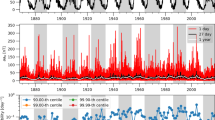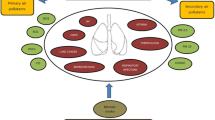Abstract
Eruptive activity of the Sun produces intensive fluxes of energetic particles and disturbances in geomagnetic field. It has been found that solar and geomagnetic activities affect the cardiovascular system. In this study, we investigated whether solar particle events (SPE) and geomagnetic storms (GS) affect risk of emergency hospitalization for first-time myocardial infarction (MI). The effect of environmental variables is analyzed separately for MI with and without elevation of ST segment in electrocardiogram. A case-crossover study design was used to analyze MI in 2,008 hospitalized patients at the Hospital of Kaunas University of Medicine, Lithuania, from January 1, 2004 to December 31, 2005. We evaluated the associations between SPE, GS, and daily number of emergency hospital admission for MI by Poisson regression, controlling for seasonal variation, weekdays, and meteorological factors. During days of SPE in conjunction with GS, the risk of hospital admissions for MI with ST elevation increased by 39 % (RR = 1.39; 95 % CI 1.02–1.91). Two days after SPE that going till GS, the risk of admission for MI without ST elevation increased by 54 % (RR = 1.54; 95 % CI 1.05–2.24). The major GS without increased proton flux with particle energies >10 MeV does not increase the risk of admission for MI without ST elevation. Only GS occurred after SPE increased the risk of admission for MI without ST elevation. These findings suggest that SPE going till GS or SPE in conjunction with GS affect on cardiovascular system. The environmental factors have different effects on the risk of myocardial infarction with and without ST elevation.

Similar content being viewed by others
References
Borovsky JE, Denton MH (2006) Differences between CME-driven storms and CIR-driven storms. J Geophys Res 111, A07S08. doi:10.1029/2005JA011447
Brasseur G, Solomon S (1986) Aeronomy of the Middle Atmosphere, vol 2. D. Reidel Publishing Company, Dordrecht
Burch JB, Reif JS, Yost MG (1999) Geomagnetic disturbances are associated with reduced nocturnal excretion of melatonin metabolite in humans. Neurosci Lett 266:209–212
Cherry NJ (2002) Schumann resonances, a plausible biophysical mechanism for the human health effects of solar/geomagnetic activity. Nat Hazards 26(3):279–331
Cornelissen G, Halberg F, Breus T, Syutkina EV, Baevsky R, Weydahl A et al (2002) Non-photic solar associations of heart rate variability and myocardial infarction. J Atmos Sol-Terr Phys 64:707–720
Dimitrova S, Stoilova I, Cholakov I (2004) Influence of local geomagnetic storms on arterial blood pressure. Βioelectromagnetics 25:408–414
Dimitrova S, Stoilova I, Georgieva K, Taseva T, Jordanova M, Maslarov D (2009) Solar and geomagnetic activity and acute myocardial infarction morbidity and mortality. Fundam Space Res, Suplement of Comptes Rend Acad Bulg Sci, pp 161–165
Dorman LI, Ptitsyna NG, Villoresi G, Kasinsky VV, Lyakhov NN, Tyasto MI (2008) Space storms as natural hazards. Adv Geosci 14:271–275
Ellison DC, Ramaty R (1985) Shock acceleration of electrons and ions in solar flares. Astrophys J 298:400–408
Fullekrug M, Fraser-Smith AC (1996) Further evidence for a global correlation of the Earth-ionosphere cavity resonances. Geophys Res Lett 23:2773–2776
Ghione S, Mezzasalma L, Del Seppia C, Papi F (1998) Do geomagnetic disturbances of solar origin affect arterial blood pressure? J Hum Hypertens 12(11):749–754
Gurfinkel’ IuI, Kuleshova VP, Oraevskiĭ VN (1998) Assessment of the effect of a geomagnetic storm on the frequency of appearance of acute cardiovascular pathology. Biofizika 43(4):654–658
Gurfinkel’ YuI, Lyubimov VV, Oraevskii VN, Parfenova LM, Yur’ev AS (1995) Effect of geomagnetic disturbances on the capillary blood flow in patients with coronary heart disease. Biophysics 40(4):793–799
Houck PD, Lethen JE, Riggs MW, Gantt DS, Dehmer GJ (2005) Relation of atmospheric pressure changes and the occurrences of acute myocardial infarction and stroke. Am J Cardiol 96(1):45–51
Ishida N, Kaneka M, Allada R (1999) Biological clocks. Proc Natl Acad Sci USA 96:8819–8820
Jackman CH, McPeters RD (2004) The Effect of solar proton events on ozone and other constituents. In: Solar variability and its effects on climate, vol 141, pp 305–319
Khabarova OV (2004) Investigation of the Tchizhevsky–Velhover effect. Biophysics 49(1):560–567
Khabarova OV, Yermolaev YuI (2008) Solar wind parameters’ behavior before and after magnetic storms. J Atmos Sol Terr Phys 70:384–390
Kleimenova NG, Kozyreva OV, Rapoport SI (2007) Pc1 geomagnetic pulsations as a potential hazard of the myocardial infarction. J Atmos Sol Terr Phys 69(14):1759–1764
Kleimenova NG, Kozyreva OV, Breus TK, Rapoport SI (2008) Seasonal variation of magnetic storm influence on myocardial infarctions. In: proceedings of 31st annual seminar physics of auroral phenomena, Apatity, 26–29 Feb, 203–205
Kolodchencko VP (1969) The number of myocardial infarctions in Kiev and geomagnetic perturbations. Solnechni Danni, Leningrad, p 107 Russian
Kozyreva OV, Kleimenova NG (2010) Variations in the ULF index of daytime geomagnetic pulsations during recurrent magnetic storms. Geomagn Aeron 50(6):770–780
Kriszbacher I, Bodis J, Csoboth I, Boncz I (2009) The occurence OFM acute myocardial infarction in relation to weather conditions. Int J Cardiol 135(1):136–138
Kuleshova VP, Pulinets SA, Kazanova ES, Kharchenko AM (2001) Biotropic effects of geomagnetic storms and their seasonal variations. Biofizika 46(5):930–934
Mendoza B, Diaz-Sandoval R (2000) Relationship between solar activity and myocardial infarctions in Mexico City. Geofísica Int 39(1):53–56
Mendoza B, Pena SS (2009) Solar activity and human health at middle and low geomagnetic latitudes in Central America. Adv Space Res 46:449–459
Miyoshi Y, Kataoka (2005) Ring current ions and radiation belt electrons during geomagnetic storms driven by coronal mass ejections and corotating interaction regions. Geophys Res Lett 32:L21105. doi:10.1029/2005GL024590
Novikova KF (1968) The effect of solar activity on the development of myocardial infarction and mortality resulting therefrom. [Russian]. Kardiologia 4:109–112
Oraevskii VN, Kuleshova VP, Gurfinkel’ IuF, Guseva AV, Rapoport SI (1998) Medico-biological effect of natural electromagnetic variations. Biofizika 43(5):844–888
Palmer SJ, Rycroft MJ, Cermack M (2006) Solar and geomagnetic activity, extremely low frequency magnetic and electric fields and human health at the Earth’s surface. Surv Geophys 27:557–595
Partonen T, Haukka J, Viilo K, Hakko H, Pirkola S, Isometsa E, Lonnqvist J, Sarkioja T, Vaisanen E, Rasanen P (2004) Cyclic time patterns of death from suicide in northern Finland. J Affect Disord 78:11–19
Pikin DA, Gurginkel IuI, Oraevskii VN (1998) Effect of geomagnetic disturbances on the blood coagulation system in patients with ischemic heart disease and prospects for correction medication. Biofizika 43(4):617–622 (in Russian)
Rodriquez-Taboada ER, Sierra-Figueredo P, Figueredo SS (2004) Geomagnetic activity related to acute myocardial infarctions: relationship in a reduced population and time interval. Geofisica Int 43(2):265–269
Roldugin VK, Beloglazov MI (2008) Schumann resonance amplitude during the forbush effect. Geomagn Aeron 48(6):768–774
Roldugin VC, Maltsev YP, Vasiljev AN, Vashenyuk EV (1999) Changes of the first Schumann resonance frequency during relativistic solar proton precipitation in the 6 November 1997 event. Ann Geophysicae 17:1293–1297
Roldugin VC, Maltsev YP, Vasiljev AN Shvets AP, Nikolaenko AP (2003) Changes of the first Schumann resonance parameters during the solar proton event of July 14, 2000. J Geophys Res 108(A3) doi:10.1029/2002JA009495
Roldugin VC, Maltsev YP, Vasiljev AN, Schokotov AY, Belyajev GG (2004) Schumann resonance frequency increase during solar X-ray bursts. J Geophys Res 108(A1). doi:10.1029/2003JA010019
Sarna S, Romo M, Siltanen P (1977) Myocardial infarction and weather. Ann Clin Res 9(4):222–232
Schlegel K (1995) EISCAT and the EISCAT data base—a tool for ionospheric modeling (E- and D-region). Adv Space Res 16(1):147–154
Schlegel K, Fullekrug M (1999) Schumann resonance parameter changes during high-energy particle precipitation. J Geophys Res 104(A5):10111–10118
Stoupel E (1999) Effect of geomagnetic activity on cardiovascular parameters. J Clin Basic Cardiol 2:34–40
Stoupel E, Joshua H, Lahav J (1996) Human blood coagulation and geomagnetic activity. Eur J Int Med 7:217–220
Stoupel E, Abramson J, Domarkiene S, Shimshoni M, Sulkes J (1997) Space proton flux and the temporal distribution of cardiovascular deaths. Int J Biometeorol 40:113–116
Stoupel E, Abramson E, Drungiliene D, Martinkėnas A, Sulkes J, Zhemaityte D (2002) Klaipėda cardiovascular emergency aid services correlate with 10 cosmo-physical parameters by time of occurence. J Clin Bas Card 5(3):225–227
Stoupel E, Abramson E, Israelevich P, Sulkes J, Harell D (2007) Dynamics of serum C-reactive protein (CRP) level and cosmophysical activity. Eur J Int Med 18:124–128
Svensmark H, Bondo T, Svensmark J (2009) Cosmic ray decreases affect atmospheric aerosols and clouds. Geophys Res Let. doi:10.1029/2009GL038429
Tycińska AM, Sawicki R, Mroczko B, Sobkowicz B, Musiał WJ, Dobrzycki S, Waszkiewicz E, Kozieradzka A, Szmitkowski M (2011) Admission B-type natriuretic peptide level predicts long-term survival in low risk ST-elevation myocardial infarction patients. Kardiol Pol 69(10):1008–1014
Veretenenko SV, Thejll P (2004) Effects of energetic solar proton events on the cyclone development in the North Atlantic. J Atmos Sol-Terr Phys 66:393–405
Veretenenko SV, Tejll P (2008) Solar proton events and evolution of cyclones in the North Atlantic. Geomagn Aeron 48(4):518–528
Villoresi G, Breus TK, Iucci N, Dorman LI, Rapoport SI (1994) The influence of geophysical and social effects on the incidence of clinically important pathologies (Moscow 1979–1981). Phys Med 10:79–91
Villoresi G, Breus TK, Dorman LI, Iuchi N, Rapoport SI (1995) Effect of interplanetary and geomagnetic disturbances on the increase in number of clinically serious medical pathologies (myocardial infarct and stroke). Biofizika 40(5):983–993
Villoresi G, Ptitsyna NG, Tiasto MI, Iucci N (1998) Myocardial infarct and geomagnetic disturbances: analysis of data on morbidity and mortality. Biofizika 43(4):623–632 (in Russian)
Watanabe Y, Corne′lissen G, Halberg F, Otsuka K, Ohkawa SI (2001) Associations by signatures and coherences between the human circulation and helio- and geomagnetic activity. Biomed Pharmacother 55(Suppl 1):76–83
Weydahl A, Sothern RB, Corne′lissen G, Wetterburg L (2001) Geomagnetic activity influences the melatonin secretion at 70 degrees N. Biomed Pharmocother 55(Suppl 1):57–62
Williams ER (1992) The schumann resonance: a global tropical thermometer. Science 256:1184–1187
Zenchenko TA (2011) Solar wind density variations and the development of heliobiological effects during magnetic storms. Atmos Oceanic Phys 47(7):795–804
Zenchenko TA, Poskotinova LV, Rekhtina AG, Zaslavskaya RM (2010) Relation between microcirculation parameters and pc3 geomagnetic pulsations. Biofizika 55(4):734–739
Acknowledgments
We acknowledge the contribution of the Kaunas University of Medicine Cardiological clinic involved in the registration of cardiovascular emergency admissions and formation of computer data basis.
Author information
Authors and Affiliations
Corresponding author
Rights and permissions
About this article
Cite this article
Vencloviene, J., Babarskiene, R. & Slapikas, R. The association between solar particle events, geomagnetic storms, and hospital admissions for myocardial infarction. Nat Hazards 65, 1–12 (2013). https://doi.org/10.1007/s11069-012-0310-6
Received:
Accepted:
Published:
Issue Date:
DOI: https://doi.org/10.1007/s11069-012-0310-6




